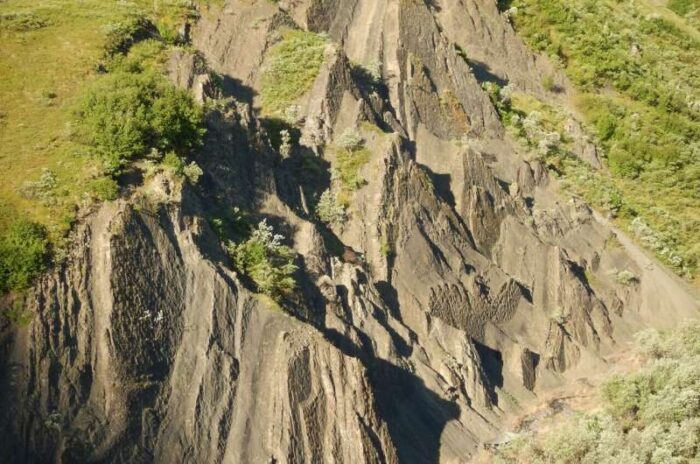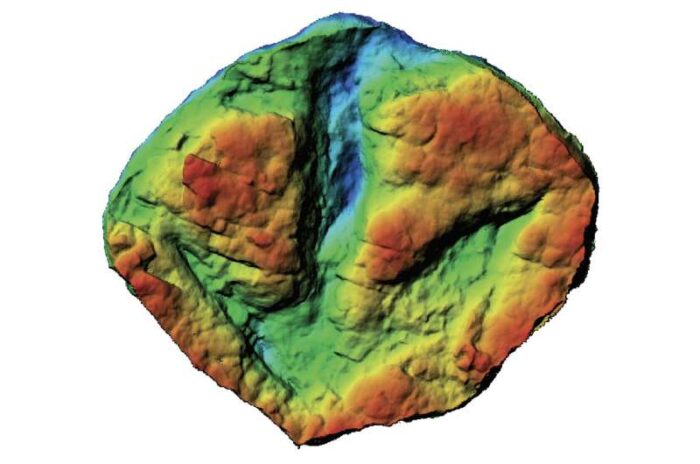Finding any sort of fossil is a pretty exciting moment for a paleontologist.
These preserved moments are rare. It requires a perfect mix of right time, right place, right conditions to have something that would normally disappear last for millions upon millions of years.
This is especially true of something like a footprint!
Think of how fast footprints fade, even in deep mud. Rains and winds come. Sun bakes the ground until it cracks and falls apart. New creatures pass by. Plants and fungi grow and disrupt the ground. So much can happen!
That is why researchers from the University of Alaska Fairbanks were "freaking out" and left "flabbergasted" by a recent discovery in Denali National Park and Reserve in Alaska. There they found a section of rock that features the tracks of not one or two or even several dinosaurs—there are literally dozens of tracks.
And even more curiously, they are found in the wall of a cliff!
Up we go!

An aerial shot of the cliffs where the fossils are located. (Patrick Druckenmiller)
Wait, dinosaurs could scale walls? No, it's not like that.
During the late Cretaceous Period, around 70 million years ago, this area would've been a muddy plain near the edge of a watering hole. Dinosaurs of all kinds would've come by to drink their fill.
Then slowly over time, this area of land buckled and was lifted on its edge by tectonic forces. (These are the very gradual movements of sections of the Earth's crust—it is the force that creates mountains and valleys, and entire continents, as well as earthquakes.)
Finally, we reach the present day. Now the flat shoreline is a nearly vertical face, towering into the sky!
Welcome to the Coliseum

An image of a tyrannosaur track from the site. (Dustin Stewart)
The researchers have nicknamed this wall "The Coliseum". This is because so many dinos gathered here.
The collection of footprints covers an entire ecosystem of prehistoric life. Most are herbivores, or plant eaters—there are juveniles and adults of many hadrosaurs (duck-billed dinos) and ceratopsians (horned dinos). But there are also carnivores, too, including raptors, flying reptiles, and even a tyrannosaur!
And then on top of that, there are tracks of birds, and fossils of shellfish, plants, and pollen. This site really has it all!
The level of detail is also very impressive, right down to being able to see the texture of the skin in some cases. Altogether, these fossils reveal a wild area that was full of life.
"It was forested and it was teeming with dinosaurs," said Pat Druckenmiller, director of the University of Alaska Museum of the North, in a statement about this place in the Cretaceous. "It was an amazing ecosystem."
 This rock face hold dozens of dino tracks, as well as other fossils. (Patrick Druckenmiller)
This rock face hold dozens of dino tracks, as well as other fossils. (Patrick Druckenmiller)









😎
This was a wonderful article. Thank you for sharing.
Loved the article. In a place called Twin, Wn., 30+ miles West of Port Angeles, the area has many fossils embedded in the cliffs for all to find!
Are you not entertained? LoL couldn’t resist..
I love to read 📚 stories about how our past was and how things were done. History has a way of repeating itself. I am wondering 🤔 what will happen in my lifetime.
Very cool! To think, dinos once inhabited a huge verdant area where Alaska now is 🦖😊
I’m very interested in the fossils and the mountains.
Hi that was nice
😮 😡 😕 😕 😎